GardenerHeaven.com is reader-supported. When you buy through links on our site, we may earn an affiliate commission.
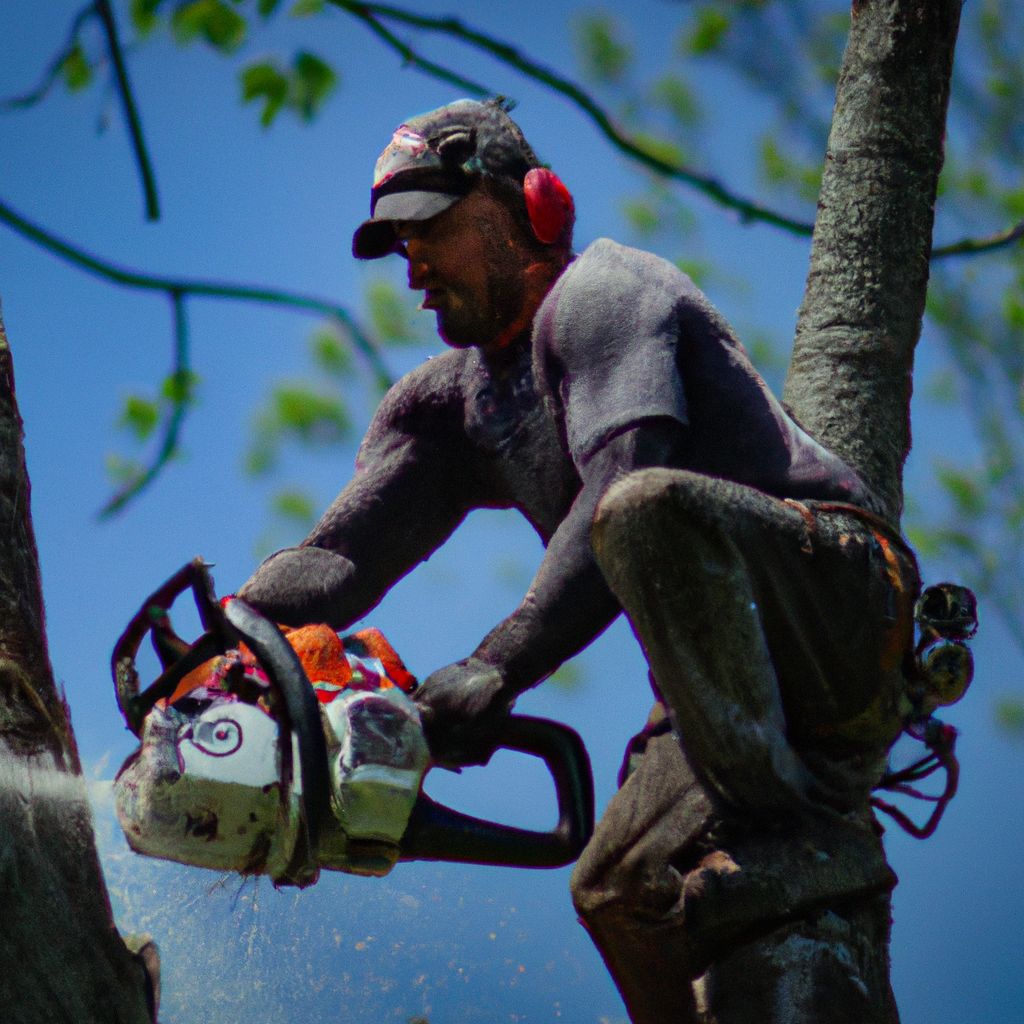
Choosing the right size chainsaw is crucial for efficient and safe use. This section will explore the importance of selecting the appropriate chainsaw size and provide an overview of the factors to consider. By understanding the significance of choosing the right chainsaw size and the various factors that come into play, you can make an informed decision to enhance your cutting performance and ensure your safety during operations.
Importance of Choosing the Right Chainsaw Size
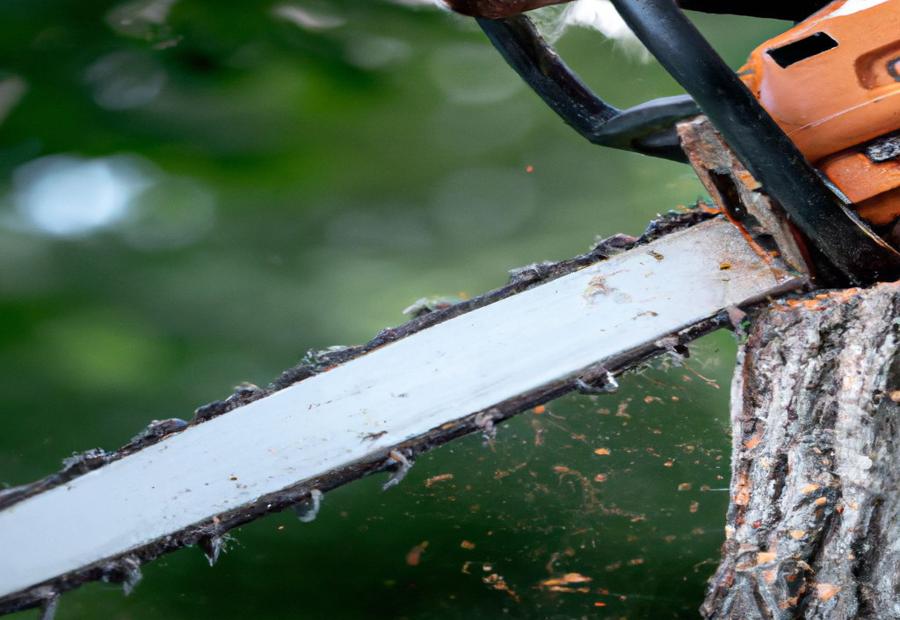
Photo Credits: Gardenerheaven.Com by Brandon Davis
Choosing the right chainsaw size is key. It affects power, efficiency, and effectiveness. The size depends on tree size, job type, and safety. Selecting the right size gives optimum performance and minimizes risks.
Tree size and type matter when choosing a chainsaw size. Thin branches? Smaller chainsaw. Thick logs? Bigger, more powerful one. Are you felling large trees? You’ll need substantial equipment.
The type of job also influences size. Home use? Less powerful tool. Commercial? Larger, more robust chainsaw.
Safety is a must. Different sizes come with varying safety features. Understand these to ensure personal safety. Hire professional or do-it-yourself? That depends on experience and confidence.
Engine power, guide bar length, and weight are also important. Engine power determines how well it cuts wood. Guide bar length affects reach. Weight is key – more power, but tiring to handle.
In conclusion, selecting the right chainsaw size is vital for optimal performance, efficiency, and safety. Assessing factors like tree size, job type, safety, engine power, guide bar length, and weight helps choose the most suitable ones.
Overview of Factors to Consider
Choosing the right size chainsaw is key for great performance and safety. Factors that need to be considered when selecting an appropriate size are:
- Tree Size and Type: What you’re cutting matters when deciding size. For thin branches and small stuff, a smaller saw is fine. But having a bigger, powerful saw for thick logs and big jobs. And for large trees, you need a heavy-duty saw.
- Job Type and Frequency: The type and frequency of use also help decide the size. A smaller or medium-sized saw is okay for home use or moderate cutting tasks. But larger and more powerful saws are necessary for commercial or hard-core cutting jobs.
- Safety Considerations: Safety features are essential when deciding on size. Different sizes of chainsaws come with various safety measures to help avoid accidents. Also, consider whether you should get a pro or do it yourself, depending on how comfortable you are with a particular saw size.
- Engine Power and Piston Displacement: Engine power and piston displacement matter when deciding size. Higher engine power usually means more cutting capacity, making it great for heavier tasks. And greater piston displacement gives a better overall performance.
- Length of the Guide Bar: The length of the guide bar is important too. A short-cutting bar is good for small branches and delicate tasks. But a longer cutting bar is needed for bigger trees and bigger jobs.
- Weight and Manageable Size: Weight and size must be taken into account. Choose a saw you can handle and maneuver without strain. That’ll ensure safe and efficient work.
Factors to Consider When Choosing the Size of a Chainsaw
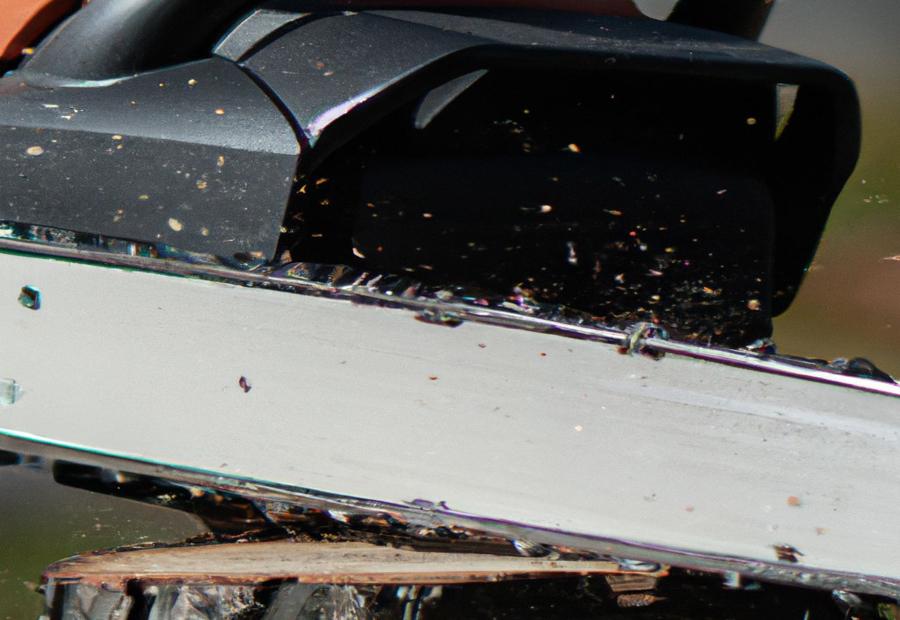
Photo Credits: Gardenerheaven.Com by George Johnson
Choosing the right size chainsaw is crucial, and several factors must be considered. This section will explore these factors, including tree size, job type, frequency, and safety considerations. By understanding these elements, you will be equipped with the knowledge to make an informed decision and ensure efficient and safe chainsaw operation.
Tree Size and Type
Choosing the right chainsaw size is important. It depends on the tree size and type. Let’s look at a breakdown of these:
| Tree Size | Chainsaw Requirements |
|---|---|
| Thin Branches | Small cutting bar for light pruning |
| Thick Logs | Medium-sized bar for medium-duty cutting |
| Felling | Large cutting bar and powerful engine |
| Large Trees | The medium-sized bar for medium-duty cutting |
These details will help pick the right chainsaw. The right chainsaw can make a big difference, whether thin branches or thick logs.
When choosing a chainsaw, it’s also important to consider other factors, such as wood density and hardness. This will help find the best chainsaw for the job.
I once cut down a large oak tree in my backyard. I asked a professional arborist for advice. They suggested using a chainsaw with a longer cutting bar. This worked well for this challenging task. It showed the importance of considering the tree size and type when picking a chainsaw.
Thin Branches and Small Projects
Choosing the right size chainsaw is key for thin branches and small projects. A shorter cutting bar allows for more precision. A lower engine power and piston displacement can cut through thin branches without being too powerful or bulky. Weight and size matter, too; a lighter chainsaw is easier to maneuver.
Safety must not be forgotten. Chainsaws with safety features like chain brakes and kickback protection are essential. Following proper cutting techniques and wearing protective gear, such as gloves, goggles, and hard hats, must be a priority.
Thick Logs and Bigger Jobs
For thicker logs and bigger projects, safety is key! Knowing the dangers and taking precautions is essential. Inexperienced individuals should consider hiring a professional for more complex tasks. When selecting a chainsaw for the job, keep these points in mind:
- Engine Power: Get a chainsaw with enough potency to cut through the log.
- Guide Bar Length: Longer bars will help with larger-diameter records.
- Weight and Manageability: Select one that is large enough yet easy to handle.
- Safety Considerations: Knowing safety features and proper cutting techniques is important.
- Maintenance: Regular maintenance is necessary for smooth operation and maximizing life.
Felling Large Trees
- Assess Tree: Check size & condition. Look for defects or decay.
- Plan Escape Route: Choose a safe spot to move away from falling debris.
- Make Cuts: Cut a horizontal notch 1/3 of the tree diameter deep on one side. On the other side, cut a flat back cut slightly above.
- Fell Tree: Insert wedges to control the direction of the fall. When the tree starts to move, retreat along the escape route.
Chainsaws come in all sizes for the pro or simple hedge trimming. Get the right size for your job!
Job Type and Frequency
When choosing a chainsaw, job type and frequency of use should be considered. This helps decide the size and power needed for optimal performance.
Consider if it’s for home projects or commercial work. Home use means smaller and less powerful. Tasks may include trimming branches, cutting firewood, and garden work.
Commercial work and heavy-duty cutting need a larger, more powerful saw. These jobs may include land clearing, falling big trees, and professional logging. Higher engine power and longer guide bar length are necessary.
Safety must always be prioritized when selecting a saw size. Choose one with safety features or seek professional help in hazardous situations.
Find the right size chainsaw to fit your needs and be safe.
Home Use and Moderate Use
For those using a chainsaw at home or moderately, it’s key to consider the exact demands of these tasks. Tree size, job type, and safety make a big difference when selecting the right chainsaw size.
There are some special particulars regarding the home or moderate use of a chainsaw. For instance, folks engaging in these activities may need a chainsaw with a short-cutting bar for tiny branches or a longer one for bigger trees. Weight and simplicity are vital considerations when picking a chainsaw for these tasks. You can find the correct chainsaw size for your home or moderate needs by looking at these details and the broader factors above.
Commercial Work and Heavy-Duty Cutting
Commercial work and heavy-duty cutting need a chainsaw to handle numerous tasks. So, size is essential for efficiency and productivity.
Important factors to consider are:
- Engine Power & Piston Displacement – for cutting ability and torque.
- Length of Guide Bar – for larger trees.
- Weight – manageable for extended periods without fatigue.
Safety is crucial for these types of jobs. Use guidelines and safe cutting techniques. Wear protective clothing and equipment.
Pro Tip: Maintenance like sharpening the chain, cleaning the air filters, and checking safety features keep your chainsaw running optimally and for longer.
Choosing the right chainsaw size: Safety is key, but so is feeling like a badass logger!
Safety Considerations
Safety Features and Risks: Chainsaws may include chain brakes, hand guards, and kickback protection to reduce the chances of accidents. One must know the potential risks of using a chainsaw, such as kickbacks and improper handling.
Hiring a Professional vs. DIY: Depending on the job and your experience, you may have to decide between hiring a professional or doing it yourself. Some tasks require special skills and knowledge which only professionals possess, hence providing a higher level of safety.
It is essential to use chainsaws correctly and follow safe-cutting techniques. Appropriate protective clothing and equipment are necessary for one’s safety.
Regularly maintaining the chainsaw’s safety features should be done for optimal performance and to reduce the risk of accidents.
Long ago, when chainsaws were first used in logging, people weren’t aware of safety measures, resulting in many injuries. Gradually, manufacturers understood the need for safety features in chainsaw designs to protect users from harm. Nowadays, modern chainsaws prioritize safety with advanced technologies like automatic chain brakes and ergonomic handles, making them safer to use.
Using the wrong size chainsaw is like performing surgery with a butter knife – it’s risky.
Safety Features and Risks
Using a chainsaw requires considering its safety features and risks. It has guards, chain brakes, and vibration dampening for added protection. However, it still has sharp blades and can cause serious injuries if incorrectly handled. Proper cutting techniques, focus, and safety gear are essential to remain safe.
For complex tasks, such as felling large trees, it is recommended to seek professional help. Arborists have the experience and knowledge to minimize injury risk and property damage. So, when considering DIY or professional use, choose wisely between a chainsaw and a chainsaw massacre!
Hiring a Professional vs. DIY
When it comes to DIY or professional chainsaw needs, there are a few things to think about. The size and type of tree can impact the decision. Job type and frequency also matter. Safety is a must.
Hiring a Professional:
- Hire a pro with expertise and experience for large trees that need felling.
- Specialized equipment and skills may be needed for commercial or heavy-duty cutting.
- For safety, a pro can make sure precautions are taken.
DIY (Do It Yourself):
- Thin branches and lightweight cutting tasks can often be handled without help.
- Individuals may do home use and moderate cutting needs.
- Consider personal capabilities and safety risks before taking on any chainsaw work.
Budget constraints or personal preferences not already mentioned should be considered too. These can have a big influence on the decision.
I had an acquaintance try to cut down a large tree without help. They weren’t experienced enough, and the job was too hard. Damage was done to the surrounding property, and emergency services had to be called. This story shows why some positions should be left to professionals.
Finding the right chainsaw size is like finding the perfect match on a lumberjack dating app!
Determining the Ideal Chainsaw Size
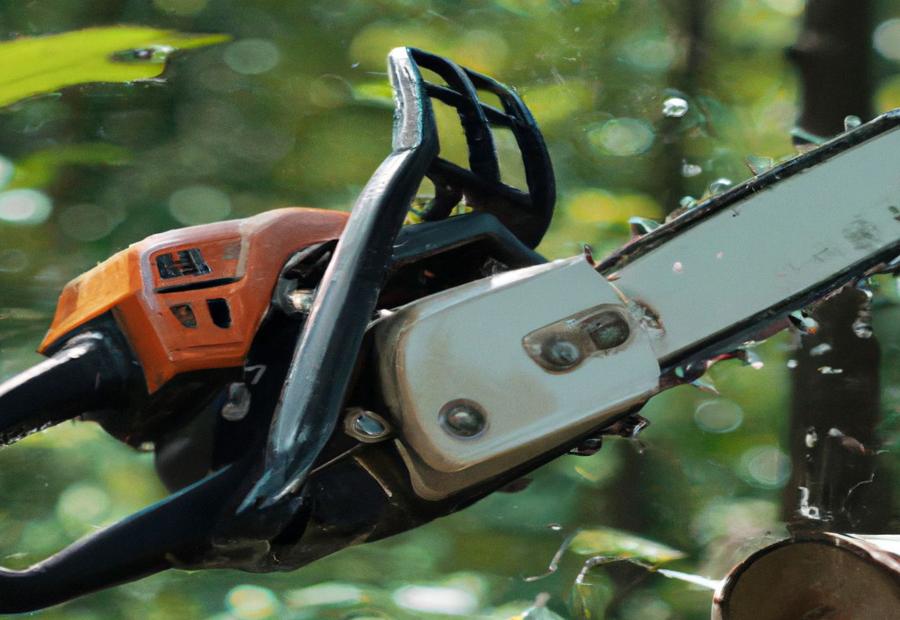
Photo Credits: Gardenerheaven.Com by Gregory Torres
When determining the ideal chainsaw size, considering factors such as engine power, guide bar length, and weight is crucial. In this section, we’ll explore how these elements influence the performance and usability of a chainsaw. We’ll uncover the significance of engine power and piston displacement, the impact of the guide bar length on cutting capabilities, and the importance of finding a weight and manageable size that suits your needs. Get ready to find the perfect chainsaw for your cutting tasks!
Engine Power and Piston Displacement
The right chainsaw size, engine power, and piston displacement are key. They affect performance and cutting capacity. Engine power is usually HP or kW. Piston displacement is cubic centimeters (cc). Higher engine power and piston displacement mean a more powerful chainsaw. But balance power and maneuverability to fit your needs. A smaller saw may be better for lighter jobs. A bigger saw may be better for heavy-duty cutting.
Aside from engine power and piston displacement, consider tree size and type, job type and frequency, safety, guide bar length, weight, and size. Consider these factors with engine power and piston displacement to pick the right size chainsaw. This is important for cutting performance and safety. Think about your specific needs and make an informed decision. Find the perfect chainsaw for easier and more manageable cutting tasks.
Length of the Guide Bar
Professionally, guide bar length is an important factor when choosing a chainsaw. The metal bar extends before the chainsaw and holds the cutting chain. It plays a big role in deciding what size of branches or trees it can cut safely and effectively.
A table with guide bar lengths, suitable tree/branch sizes, and applications is helpful. Finding the right guide bar length for a specific task is easier. Longer guide bars are for larger trees, while shorter ones are for smaller branches. The size affects the reach and capabilities of the chainsaw. Thus, selecting the right guide bar length increases productivity and safety.
Short Cutting Bar for Small Branches
A short-cutting bar is great for trimming small branches precisely and effortlessly. The length of the cutting bar decides the maximum width of components that can be easily cut. With a shorter cutting bar, moving in cramped spaces and going around objects while keeping control of the chainsaw is easier.
Here’s a 6-step guide to using a short-cutting bar for small branches:
- Check the diameter of the unit: Before you start, evaluate the size of the branch you need to cut. A short-cutting bar works best for components of a smaller diameter.
- Secure the area: Make sure the area around the branch is clear and secure before beginning any cutting. Remove any potential hazards or objects that might interfere.
- Good positioning: Grip the handles of the chainsaw securely with both hands, ensuring you have a stable stance.
- Start at an angle: Approach the branch from an angle to create a groove by making a diagonal cut on one side.
- Cut from above. After you’ve made a groove, make a straight cut from the top until you’ve severed the branch.
- Repeat if necessary: If more branches or cuts are needed, repeat steps 4 and 5 until all desired cuts are made.
To get a successful and efficient cut, it’s important to pick a chainsaw with a suitable length of guide bar for your needs. In this case, when dealing with small branches, going for a short-cutting bar will give you control and accuracy during cutting.
Longer Cutting Bar for Larger Trees
A longer cutting bar is essential for larger trees. It provides the needed reach and capacity to cut through the thick trunks and branches. More maneuverability lets you make accurate and precise cuts. Plus, it gives you more surface area, allowing for faster and more efficient cutting. And it reduces the need for frequent repositioning when handling bigger projects.
When selecting a chainsaw size, it’s important to focus on the length of the guide bar for larger trees. A 20-36 inch bar is recommended. This gives you enough leverage, better handling, and improved cutting stability.
Safety is key when using longer cutting bars for larger trees. Wear protective clothing, gloves, a helmet, safety glasses, hearing protection, and boots with good traction. Also, inspect the safety features and maintain them according to manufacturer guidelines.
Regular maintenance is important for chainsaw lifespan and performance. Sharpen the chainsaw chain and lubricate it properly. And choose a lightweight chainsaw for better handling.
Weight and Manageable Size
We can use the reference data to make a table detailing the link between the weight and size of chainsaws. The table will show various options dependent on preferences or needs.
| Chainsaw Weight | Manageable Size |
|---|---|
| Lightweight (under 10 lbs) | Simple to move for small projects |
| Moderate weight (10-15 lbs) | Perfect for general use |
| Heavyweight (over 15 lbs) | Offers steadiness for heavy-duty cutting |
By displaying this info in a tabular format, users can easily compare different chainsaw options connected to their weight and size.
It’s important to bear in mind that while weight and size are important when selecting a chainsaw, other features such as engine power, guide bar length, and safety features must be taken into account too. These elements work together with weight and size to guarantee ideal performance and user safety. So, it is necessary to consider all these factors collectively to pick the most suitable chainsaw for your necessities.
Safety Considerations
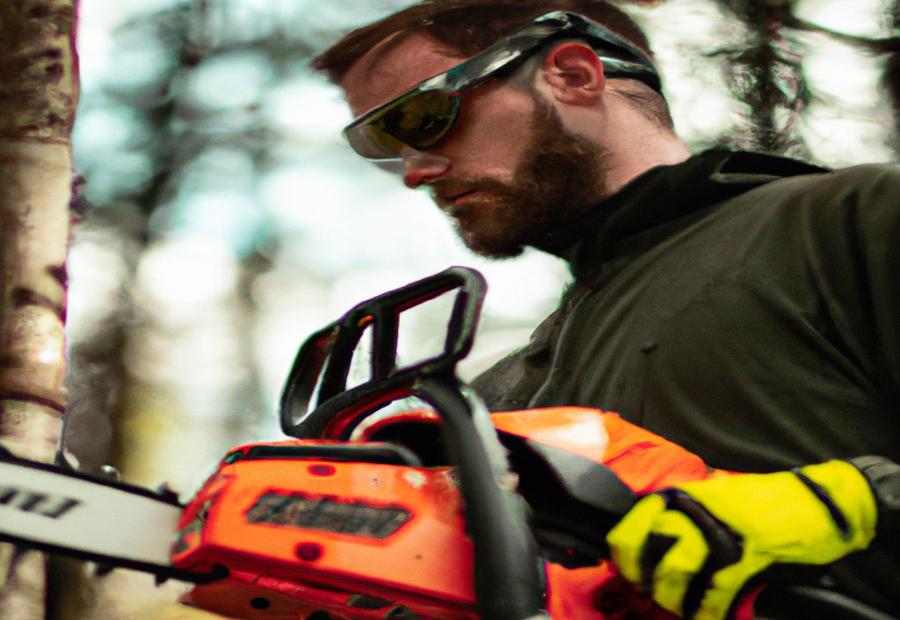
Photo Credits: Gardenerheaven.Com by Jack Campbell
When it comes to using a chainsaw, safety should always be the top priority. This section will explore the essential safety considerations every chainsaw user should consider. From proper use and safe cutting techniques to the necessary safety gear and precautions, we will cover all the crucial aspects of ensuring a secure and accident-free chainsaw experience. Let’s dive in and discover how to stay safe while getting the job done effectively.
Proper Use and Safe Cutting Techniques
Prioritize safety when using your chainsaw! Don’t let speed or convenience take precedence. Follow guidelines to reduce risks.
Read the manual for your specific chainsaw model. Get trained or get advice from experienced professionals. Wear the right gear. Chainsaws and hospital visits don’t mix!
Safety Gear and Precautions
When using a chainsaw, safety gear and precautions are a must! Wear a helmet with face protection, goggles or safety glasses, ear protection, thick gloves, long pants, and anti-slip boots. You will also want to regularly check the chain tension, lubrication system, fuel levels, and overall tool condition.
When cutting, maintain a stable stance, keep both hands on the tool, use proper grip techniques, and avoid missing above shoulder height. Training and experience with handling techniques are also recommended before using a chainsaw.
An example of how safety gear can save lives: A logger was working in dense forestry. He lost his balance while wielding his chainsaw – but his helmet and anti-slip boots saved him from serious injury. This story highlights the importance of wearing the right safety gear when using a chainsaw.
Protective Clothing and Equipment
Don’t forget to wear protective gear when using a chainsaw! Such as:
- Chainsaw Chaps – special pants that protect your legs from the blade.
- Safety Helmet – with face shield and ear muffs to protect your head, face, and ears.
- Gloves – thick and durable to protect your hands.
- Chainsaw Boots – sturdy with steel toe caps for protection.
- Eye Protection – safety goggles or glasses to shield your eyes from debris.
- Hearing Protection – ear plugs or earmuffs to reduce noise levels.
It’s important to inspect and maintain these items often. Replace any damaged gear to keep you safe. Invest in quality chainsaw protective gear – it might cost more, but it’s worth it in the long run! Lastly, follow proper procedures and practice safe-cutting techniques for a smooth and worry-free experience.
Safety Features and Maintenance
Chainsaws come with essential safety features, such as an automatic chain brake. This enables the chain to stop instantly if kickback occurs or if movement is sudden. It minimizes the risk of injury. An anti-vibration system is also important. It reduces fatigue and improves comfort during prolonged use. Plus, it increases control and precision.
A chain catcher is between the handlebar and engine housing. It catches the chain if it derails or breaks, preventing potential injuries. Some chainsaws also have a tool-less chain tensioning system, allowing easy adjustment without extra tools.
Air filtration systems protect debris from entering the engine to maintain engine performance. Cleaning the air filter regularly is key. Additionally, regular maintenance tasks are necessary. These include cleaning the chainsaw after use, sharpening the chain, keeping fuel fresh, and following the manufacturer’s guidelines.
To illustrate the importance of safety and maintenance, let me share an example. A chainsaw user neglected regular maintenance. Consequently, the air filter became clogged, and the engine overheated. Ultimately, it caused engine failure and costly repairs.
So, safety features and maintenance should never be neglected. They’ll help to keep your chainsaw safe and functional. By taking these steps, you can maintain optimal performance and longevity.
Choosing the Best Chainsaw Type
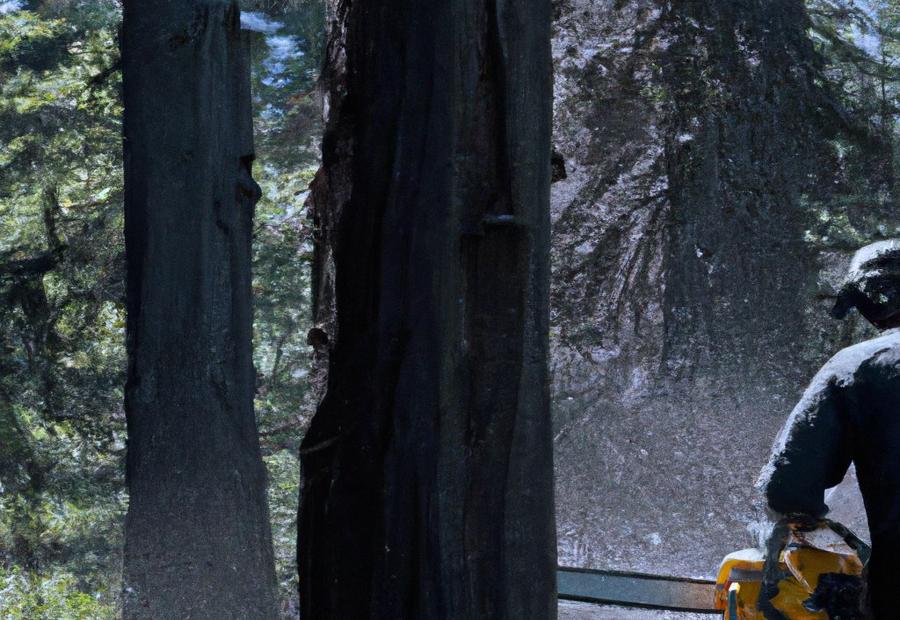
Photo Credits: Gardenerheaven.Com by Henry Martinez
When choosing the best chainsaw type, a few options exist. Each class has unique advantages and considerations, from electric chainsaws to gas-powered and battery-powered ones. This section explores the different chainsaw types and what sets them apart, helping you decide on the right chainsaw for your needs.
Electric Chainsaws
Electric chainsaws are usually lighter and simpler to handle than gas-powered ones. This makes them a great choice for those with less upper body strength or who prefer something lightweight. They are also quieter than gas-powered chainsaws, which can be useful in residential areas or noise-sensitive environments. Electric chainsaws don’t require fuel, so they don’t emit harmful fumes – making them more eco-friendly than gas-powered saws. And they need little maintenance – no oil changes or fuel mixing.
However, electric chainsaws are limited in mobility since they need a power source nearby – either an outdoor electrical outlet or a long extension cord. Despite this, they are suitable for light to moderate cutting tasks around the home.
Electric chainsaws are special because they deliver consistent power without frequent fueling or maintenance like other chainsaws. But, safety should always be considered when operating any chainsaw, with protective clothing and gear being worn and proper cutting techniques followed.
For extra info on electric chainsaw maintenance, chain replacement, recommended brands, and accessories, check out the article “What Size Chainsaw Do I Need: Factors to Consider and Choosing the Right Saw.”
Gas-Powered Chainsaws
Gassed-up chainsaws offer advantages other powered models don’t. An important one is engine strength. Gas-powered engines are usually larger, able to tackle more difficult work like felling big trees or cutting through tough logs.
Take the bar length into account. The length of the guide bar on a gas-powered chainsaw influences what size material it can slice. Longer bars are great for bigger trees and thicker branches, and shorter bars are better for small projects.
Weight is also important. Gas-powered saws have a fuel tank and engine, which makes them heavier than electric or battery-powered saws. Pick a chainsaw that isn’t too tiring to hold and use.
Safety features are another plus of gas-powered chainsaws. Many come with chain brakes and anti-vibration systems, keeping accidents at bay and making the saws easier to use.
Think about what you need before choosing a gas-powered chainsaw. Consider the job type and frequency. A smaller gas-powered chainsaw is enough for occasional home projects or moderate use. Heavier duties or commercial work require a bigger, more powerful model.
You can pick the right size by considering your needs and gas-powered chainsaw details. Whether you’re working on thin branches or felling huge trees, gas-powered saws provide the power to get the job done quickly and efficiently.
Gas-powered chainsaws have been around in the logging industry for a long time. They’re perfect for professionals in forestry and timber operations. Technological advancements have made gas-powered saws more available to homeowners and DIYers. They remain a favorite for those looking for serious cutting power.
Battery-Powered Chainsaws
Battery-powered chainsaws have skyrocketed in popularity among homeowners and professionals. These chainsaws possess numerous advantages, making them a convenient and eco-friendly option for cutting wood.
Firstly, they are feather-light and portable – easy to use and maneuver for small- to medium-sized jobs, such as pruning or cutting firewood. Secondly, they are quieter and vibrate less than gas-powered chainsaws – ideal for residential areas with noise limits.
Thirdly, they are emissions-free, eliminating the need for gasoline and reducing air pollution. Additionally, modern lithium-ion batteries make them longer-lasting and more powerful.
They also require less maintenance than gas-powered chainsaws: no fuel mixing or regular maintenance tasks, like spark plug changes or carburetor cleaning.
Finally, battery-powered chainsaws offer a hassle-free start with the press of a button – no multiple pulls or choke adjustments, increasing efficiency and reducing user fatigue.
To sum up, battery-powered chainsaws are a versatile and practical tool for cutting wood, offering convenience, environmental friendliness, and efficiency.
Additional Resources and Buying Guides
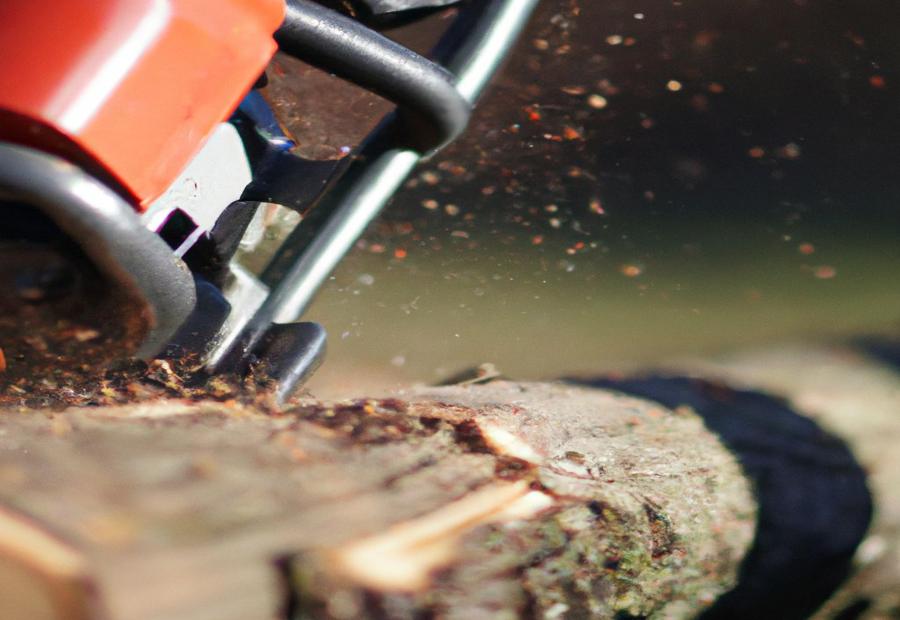
Photo Credits: Gardenerheaven.Com by Jose Wilson
Discover additional resources and buying guides to enhance your chainsaw knowledge and help you make informed decisions. Uncover essential chainsaw and general maintenance tips, learn about chain replacement and guide bar length considerations, and explore recommended chainsaw accessories and trusted brands. Empower yourself with the right information to maximize the efficiency and durability of your chainsaw.
Chainsaw Maintenance and General Maintenance Tips
Chainsaw maintenance is key for its optimal performance and longevity. To keep it in good condition and minimize accidents, follow these tips:
- Clean after each use to remove debris and avoid buildup.
- Regularly check and refill the oil reservoir for proper lubrication.
- Keep the chain sharp to enhance cutting efficiency and reduce strain on the motor.
Furthermore, inspect other components like spark plugs, air filters, and fuel lines for optimal performance.
Cleaning your chainsaw often will extend its life. Don’t forget to choose the right size and guide bar length, and replace the chain when dull or damaged.
Chainsaw Chain Replacement and Guide Bar Length
Let’s look at the data to comprehend the importance of chainsaw chain replacement and guide bar length.
The data expresses that a shorter cutting bar is good for small branches (thin branches and small projects), allowing better control. A longer cutting bar benefits larger trees (thick logs and bigger jobs) as it provides more cutting capacity. Therefore, the guide bar size should be chosen based on the size of the tree or project.
The data also mentions engine power and piston displacement as factors for chainsaw size. This shows that chainsaws with more engine power and bigger piston displacement might require longer guide bars and stronger chains to do tough cutting tasks.
Finally, it is important to pick an appropriate guide bar length depending on the size of the tree or project. This will ensure efficient cutting performance while keeping safety measures in place.
Now, let’s go into more detail in a table format:
| Cutting Bar Size | Suitable Application |
|---|---|
| Short | Small branches |
| Long | Larger trees |
This table clarifies how different cutting bar sizes suit specific applications. It makes it easier to decide by presenting data in an orderly way.
Chainsaw Accessories and Recommended Brands
Chainsaw accessories and brands are must-haves when you choose a chainsaw. Keep these key points in mind:
- Chainsaw accessories: Get tools that boost performance and functionality. Examples include safety gloves, goggles, hearing protection, and chain sharpening tools. Buy quality accessories that fit your chainsaw model.
- Recommended brands: Choose a reliable brand. Popular brands include Stihl, Husqvarna, and Echo. They make high-quality saws for different tasks.
- Specialized accessories: Get specialized attachments for special tasks, like pole saws for high branches and carving bars for wood carving—research compatible attachments for your jobs.
- Maintenance products: Chainsaws need maintenance to work well and last. Use trusted brands’ products, like lubricants or fuel stabilizers.
In conclusion, choose quality and reputable brands when choosing accessories and brands. Also, get specialized attachments and essential maintenance products.
Conclusion

Photo Credits: Gardenerheaven.Com by Bobby Perez
Our reference data proves that selecting the right size chainsaw is super important. The type of wood, use, and cutting capacity should all be considered. A bigger bar length is good for larger trees and hard jobs. But a smaller saw is better if you’re a novice or doing light work. The weight and handle should be considered for safety and comfort.
Some Facts About “What Size Chainsaw Do I Need”:
- ✅ The size of the chainsaw depends on the length of the guide bar. (Source: Team Research)
- ✅ The guide bar length can be determined by using a tape measure. (Source: Team Research)
- ✅ The chainsaw should be at least 2 inches longer than the thickness of the branch or tree being cut. (Source: Team Research)
- ✅ The power of the engine is proportional to the length of the guide bar. (Source: Team Research)
- ✅ Most chainsaws allow for blade swapping, but it is not recommended to go more than two additional inches longer than the manufacturer’s supplied blade. (Source: Team Research)
FAQs about What Size Chainsaw I Need
What factors should I consider when choosing the right size chainsaw?
Answer: When choosing the right size chainsaw, you should consider factors such as the type of work you will be doing, the size of the trees or branches you will be cutting, your experience level, and your physical strength. It is also important to consider ergonomics, safety features, maintenance requirements, and the wood you will be cutting.
What size chainsaw is recommended for felling medium trees?
Answer: A chainsaw with a guide bar length of 16″ to 18″ is recommended for felling medium trees. This size provides enough power and cutting capacity to safely and efficiently fell medium-sized trees.
Can I use a smaller chainsaw to cut down larger trees?
Answer: Using a smaller chainsaw to cut down larger trees is not recommended. Smaller chainsaws may not have sufficient power or cutting capacity to handle the size of the tree, which can cause increased wear on the chainsaw and pose safety risks. Choosing a chainsaw with an appropriate guide bar length is best for the size of the tree you will be feeling.
What size chainsaw should I use for splitting firewood?
Answer: It is recommended to use a chainsaw with a guide bar length of 14″ to 16″ for splitting firewood. This size provides enough cutting capacity to efficiently and effectively break firewood into manageable pieces.
Is it necessary to own several chainsaw models for different tasks?
Answer: Owning several chainsaw models for different tasks is unnecessary but can be beneficial. Access to chainsaws with different guide bar lengths allows you to choose the right size for each job. However, if you only need a chainsaw for occasional use or have limited storage space, owning one with a versatile guide bar length can still meet most of your needs.
What should I do if my chainsaw is too small for the task?
Answer: If your chainsaw is far too small for the task at hand, it is recommended to consider purchasing a larger chainsaw or hiring a professional. Using a too-small chainsaw may require multiple passes to cut through completely, which can be time-consuming and inefficient. It may also strain the chainsaw and increase the risk of accidents.




